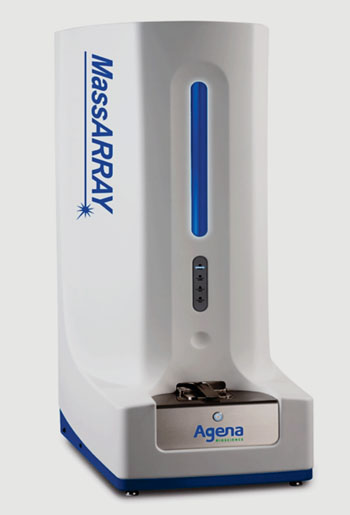New Light Shed on the Cause of Chronic Fatigue Syndrome
|
By LabMedica International staff writers Posted on 27 May 2015 |

Image: The MassARRAY mass spectrometer (Photo courtesy of Agena Bioscience).
The transient receptor potential (TRP) superfamily in humans comprises 27 cation channels with permeability to monovalent and divalent cations and these channels are widely expressed within humans on cells and tissues and have significant sensory and regulatory roles on most physiological functions.
Chronic fatigue syndrome/myalgic encephalomyelitis (CFS/ME) is a highly debilitating disorder characterized by profound fatigue, muscle and joint pain, cerebral symptoms of impaired memory and concentration, impaired cardiovascular function, gut disorder and sensory dysfunction such as noise intolerance and balance disturbance.
Scientists at Griffith University (Gold Coast, QLD, Australia) and their colleagues recruited 115 CFS patients and 90 non-fatigued controls. Of the115 CFS patients (mean age: 48.7 ± 1.1 years), 84 (73.04%) were women and 31 (26.96%) were men. The 90 non-fatigued controls (mean age: 46.5 ± 1.2 years) comprised 59 (65.56%) women and 31 (34.44%) men. Ten milliliters of whole blood samples were collected from all participants in to ethylenediaminetetraacetic acid tubes.
Genomic DNA was extracted from all whole blood samples using the Qiagen DNA blood mini-kit (Qiagen; Venlo, Netherlands). The Nanodrop (Nanodrop; Wilmington, DE, USA) was used to assess the quality and quantity of the DNA extracted. Approximately 2 μg of genomic DNA was used in the single nuclear polymorphisms (SNP) assay. SNP analysis was performed using the MassARRAY iPLEX Gold Assay and following the iPLEX Gold reaction, MassARRAY was performed using the MassARRAY mass spectrometer, (Agena Bioscience; San Diego, CA, USA).
Of the 240 SNPs that were examined in the study, 233 were successfully identified in both participants groups and 13 were observed to be significantly associated with CFS. Nine of these SNPs were associated with transient receptor potential melostatin (TRPM3) while the remaining SNPs were associated with TRPA1 (ankyrin) and TRPC4 (canonical).
Pete Smith, MBBS, FRACP, PhD, a professor of immunology and a coauthor of the study said, “Important signaling mechanisms are disrupted as a result of these genetic changes involving the detection and response to threats. These are primitive genes that are involved in many cellular signals in the brain, gut, cardiovascular and immune systems, as well as in the mediation of pain.” The study was published on May 10, 2015, in the journal Immunology and Immunogenetics Insights.
Related Links:
Griffith University
Qiagen
Agena Bioscience
Chronic fatigue syndrome/myalgic encephalomyelitis (CFS/ME) is a highly debilitating disorder characterized by profound fatigue, muscle and joint pain, cerebral symptoms of impaired memory and concentration, impaired cardiovascular function, gut disorder and sensory dysfunction such as noise intolerance and balance disturbance.
Scientists at Griffith University (Gold Coast, QLD, Australia) and their colleagues recruited 115 CFS patients and 90 non-fatigued controls. Of the115 CFS patients (mean age: 48.7 ± 1.1 years), 84 (73.04%) were women and 31 (26.96%) were men. The 90 non-fatigued controls (mean age: 46.5 ± 1.2 years) comprised 59 (65.56%) women and 31 (34.44%) men. Ten milliliters of whole blood samples were collected from all participants in to ethylenediaminetetraacetic acid tubes.
Genomic DNA was extracted from all whole blood samples using the Qiagen DNA blood mini-kit (Qiagen; Venlo, Netherlands). The Nanodrop (Nanodrop; Wilmington, DE, USA) was used to assess the quality and quantity of the DNA extracted. Approximately 2 μg of genomic DNA was used in the single nuclear polymorphisms (SNP) assay. SNP analysis was performed using the MassARRAY iPLEX Gold Assay and following the iPLEX Gold reaction, MassARRAY was performed using the MassARRAY mass spectrometer, (Agena Bioscience; San Diego, CA, USA).
Of the 240 SNPs that were examined in the study, 233 were successfully identified in both participants groups and 13 were observed to be significantly associated with CFS. Nine of these SNPs were associated with transient receptor potential melostatin (TRPM3) while the remaining SNPs were associated with TRPA1 (ankyrin) and TRPC4 (canonical).
Pete Smith, MBBS, FRACP, PhD, a professor of immunology and a coauthor of the study said, “Important signaling mechanisms are disrupted as a result of these genetic changes involving the detection and response to threats. These are primitive genes that are involved in many cellular signals in the brain, gut, cardiovascular and immune systems, as well as in the mediation of pain.” The study was published on May 10, 2015, in the journal Immunology and Immunogenetics Insights.
Related Links:
Griffith University
Qiagen
Agena Bioscience
Latest Molecular Diagnostics News
- World's First NGS-Based Diagnostic Platform Fully Automates Sample-To-Result Process Within Single Device
- Rapid Diagnostic Breakthrough Simultaneously Detects Resistance and Virulence in Klebsiella Pneumoniae
- DNA Detection Platform Enables Real-Time Molecular Detection
- STI Molecular Test Delivers Rapid POC Results for Treatment Guidance
- Blood Biomarker Improves Early Brain Injury Prognosis After Cardiac Arrest
- Biomarkers Could Identify Patients at High Risk of Severe AKI After Major Surgery
- CLIA Test Identifies Head and Neck Cancer Recurrence from Post-Surgical Lymphatic Fluid
- New 15-Minute Hepatitis C Test Paves Way for Same-Day Treatment
- Ovarian Cancer Assay Outperforms Traditional Tests in Early Detection
- Ultrasensitive Method Detects Low-Frequency Cancer Mutations
- Blood Test Enables Non-Invasive Endometriosis Detection
- New Blood Biomarkers Help Diagnose Pregnancy-Linked Liver Complication
- Simple Urine Test to Revolutionize Bladder Cancer Diagnosis and Treatment
- Blood Test to Enable Earlier and Simpler Detection of Liver Fibrosis
- Genetic Marker to Help Children with T-Cell Leukemia Avoid Unnecessary Chemotherapy
- Four-Gene Blood Test Rules Out Bacterial Lung Infection
Channels
Clinical Chemistry
view channel
Noninvasive Blood-Glucose Monitoring to Replace Finger Pricks for Diabetics
People with diabetes often need to measure their blood glucose multiple times a day, most commonly through finger-prick blood tests or implanted sensors. These methods can be painful, inconvenient, and... Read more
POC Breath Diagnostic System to Detect Pneumonia-Causing Pathogens
Pseudomonas aeruginosa is a major cause of hospital-acquired and ventilator-associated pneumonia, particularly in lung transplant recipients and patients with structural lung disease. Its ability to form... Read moreMolecular Diagnostics
view channel
World's First NGS-Based Diagnostic Platform Fully Automates Sample-To-Result Process Within Single Device
Rapid point-of-need diagnostics are of critical need, especially in the areas of infectious disease and cancer testing and monitoring. Now, a direct-from-specimen platform that performs genomic analysis... Read more
Rapid Diagnostic Breakthrough Simultaneously Detects Resistance and Virulence in Klebsiella Pneumoniae
Antibiotic resistance is a steadily escalating threat to global healthcare, making common infections harder to treat and increasing the risk of severe complications. One of the most concerning pathogens... Read moreHematology
view channel
MRD Tests Could Predict Survival in Leukemia Patients
Acute myeloid leukemia is an aggressive blood cancer that disrupts normal blood cell production and often relapses even after intensive treatment. Clinicians currently lack early, reliable markers to predict... Read more
Platelet Activity Blood Test in Middle Age Could Identify Early Alzheimer’s Risk
Early detection of Alzheimer’s disease remains one of the biggest unmet needs in neurology, particularly because the biological changes underlying the disorder begin decades before memory symptoms appear.... Read more
Microvesicles Measurement Could Detect Vascular Injury in Sickle Cell Disease Patients
Assessing disease severity in sickle cell disease (SCD) remains challenging, especially when trying to predict hemolysis, vascular injury, and risk of complications such as vaso-occlusive crises.... Read more
ADLM’s New Coagulation Testing Guidance to Improve Care for Patients on Blood Thinners
Direct oral anticoagulants (DOACs) are one of the most common types of blood thinners. Patients take them to prevent a host of complications that could arise from blood clotting, including stroke, deep... Read moreMicrobiology
view channel
New UTI Diagnosis Method Delivers Antibiotic Resistance Results 24 Hours Earlier
Urinary tract infections affect around 152 million people every year, making them one of the most common bacterial infections worldwide. In routine medical practice, diagnosis often relies on rapid urine... Read more
Breakthroughs in Microbial Analysis to Enhance Disease Prediction
Microorganisms shape human health, ecosystems, and the planet’s climate, yet identifying them and understanding how they are related remains a major scientific challenge. Even with modern DNA sequencing,... Read morePathology
view channel
AI Tool Simultaneously Identifies Genetic Mutations and Disease Type
Interpreting genetic test results remains a major challenge in modern medicine, particularly for rare and complex diseases. While existing tools can indicate whether a genetic mutation is harmful, they... Read more
Rapid Low-Cost Tests Can Prevent Child Deaths from Contaminated Medicinal Syrups
Medicinal syrups contaminated with toxic chemicals have caused the deaths of hundreds of children worldwide, exposing a critical gap in how these products are tested before reaching patients.... Read more
Tumor Signals in Saliva and Blood Enable Non-Invasive Monitoring of Head and Neck Cancer
Head and neck cancers are among the most aggressive malignancies worldwide, with nearly 900,000 new cases diagnosed each year. Monitoring these cancers for recurrence or relapse typically relies on tissue... Read moreTechnology
view channel
Diagnostic Chip Monitors Chemotherapy Effectiveness for Brain Cancer
Glioblastoma is one of the most aggressive and fatal brain cancers, with most patients surviving less than two years after diagnosis. Treatment is particularly challenging because the tumor infiltrates... Read more
Machine Learning Models Diagnose ALS Earlier Through Blood Biomarkers
Amyotrophic lateral sclerosis (ALS) is a rapidly progressive neurodegenerative disease that is notoriously difficult to diagnose in its early stages. Early symptoms often overlap with other neurological... Read moreIndustry
view channel
BD and Penn Institute Collaborate to Advance Immunotherapy through Flow Cytometry
BD (Becton, Dickinson and Company, Franklin Lakes, NJ, USA) has entered into a strategic collaboration with the Institute for Immunology and Immune Health (I3H, Philadelphia, PA, USA) at the University... Read more










 (3) (1).png)











